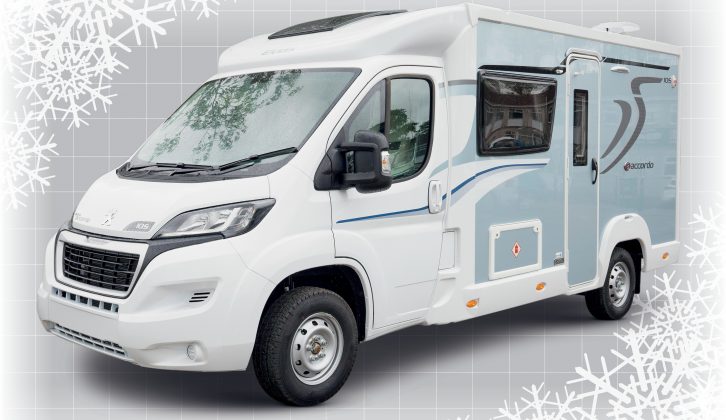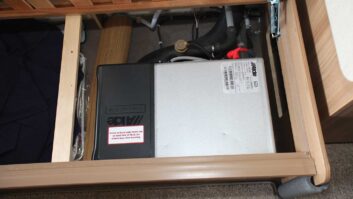Are you preparing to head off for some winter sun?
Maybe you’re going to be hitting the slopes?
Or perhaps you’re packing your ’van away and storing it until the sun returns in spring.
Whatever your plans this winter, cold weather at this time of year can play havoc with your motorhome and its systems – but there are numerous precautions that you can take.
Insulation
Newer motorhomes have sufficient insulation and heating for all seasons, but if you have an older camper van, for example, it pays to invest in window insulation panels.
Many come with suckers that simply stick to your window, but you can also source custom-made panels.
Bubble wrap is an effective alternative if you’re keeping to a budget.
Other areas where you’ll lose heat are your roof and floor.
Consider adding underlay to the latter, and choose from a variety of roof-insulation options (we’ve invested in a pop-top wrap, which uses quick-release clips and tensioned straps).
Mechanics
Make sure that your water has enough antifreeze and remember to use winter-grade oil, which is designed for below-zero temperatures.
Check your owner’s manual to find out which oil is best.
When it comes to cooking in winter, it pays to open a window to cut condensation.
It is not your friend, so let air circulate – or invest in a small dehumidifier.
Storage
Whatever the age of your motorhome, leaving it stationary for lengthy periods isn’t ideal.
A garage is perfect if you’re not planning on holidaying in winter but, for many of us, that simply isn’t practical.
Even if you have room on your driveway, you need to beware of trees – leaves, bird droppings and wayward branches can damage paint.
If you can’t fit your ’van in your garage, consider renting one or asking friends if they have space.
If you are going to use your motorhome throughout the winter, skirting (which can be attached via the sill, or by using clamps, bungee loops, suction hoops or studs) can prevent draughts and help you get moving more quickly when you are snowed in.
Even an inflatable draught skirt, more suited to smaller ’vans, will provide basic protection from the wind.
Tyres
Winter brings much greater risk of tyre deterioration, so you should keep checking your tyre pressures!
It goes without saying that if you’re continuing to tour, you could well benefit from winter tyres.
Tyre chains are also a sound investment, and a legal requirement in some European countries.
Fail to prepare, prepare to fail…
Paintwork
The elements can make mincemeat of paintwork blemishes.
Make a note of any areas that need work, including green or black mould, and try to get them touched up to prevent rust.
Workshops and garages are quieter at this time of year, so there’s no excuse.
It’s also worth giving your motorhome one final clean before you put it away – dirt can retain moisture, which can lead to rust or rot.
Remember to extend your awning, and ensure that it’s clean and dry before packing it away, otherwise the smell in spring when you reopen for business will best be described as ‘musty’!
To cover or not?
One default setting for those hibernating is to protect the motorhome with some form of tarpaulin or specialised cover.
However, a little caution is advisable here, because some covers can prevent air from circulating. Check your cover for levels of breathability.
Pro-tec, just one example, makes covers that allow the moisture to evaporate, which means they are breathable enough to protect your pride and joy from mould, mildew and condensation.
Whichever cover you choose, make sure that it fits well – too big and it can flap about in windy conditions.
Each time you use it, check there are no holes in it.
Another alternative is to apply a waxy protective coating, which can be cleaned off in spring.
Ticking over
When it comes to the older motorhome, the temptation is to start the engine as regularly as possible.
But do this too often and you’re at risk of depositing moisture in the exhaust system, which can form acids and rust.
Instead, start up once a month and leave it running idly for more than 15 minutes.
Top-ups
Even if you’re not planning on touring in winter, it pays to keep everything topped up and charged – remember to turn everything off, too.
Topping up oil, charging the battery and lubricating any moving parts will help it all to move better next year.
If you are hooked up, power the heating. If you can’t do so, consider disconnecting the leisure battery and charging it periodically.
Better still, turn on appliances from time to time, to ensure everything is working.
Drain away
Drain all the water from your storage tanks, including the waste tank, and ensure your taps are free from any surplus water (going for a short drive can help with this).
This will ensure there’s nothing to freeze and expand when the temperatures drop, protecting all tanks and pipes. Some choose to insulate their pipes.
Make sure that all gas valves are turned off and remove propane/butane bottles – if possible – and store in a safe place.
If you are touring during a big freeze, ensure your gas tanks are full. Disconnect the water hose every so often and don’t fill water tanks too high.
Clean, clean, clean
Pay particular attention to the cupboards and cooking areas inside your motorhome, and keep them clean.
Remove any leftover food or crumbs that might tempt unwanted visitors (you might even consider setting some mouse traps).
Open and shut
Store all bedding indoors and leave mattresses standing upright to prevent mildew.
Do whatever you can to ensure good air circulation in the interior.
Leave cupboard doors and the fridge door ajar, and defrost the freezer.
Shut windows and rooflights, opening them from time to time to air the interior – close vents to keep out insects.
Apply WD-40 or thin oil to protect against rust.
If you do go touring, pack some extra layers… and a hot water bottle!
Whatever the age of your motorhome, leaving it stationary for lengthy periods isn’t ideal









